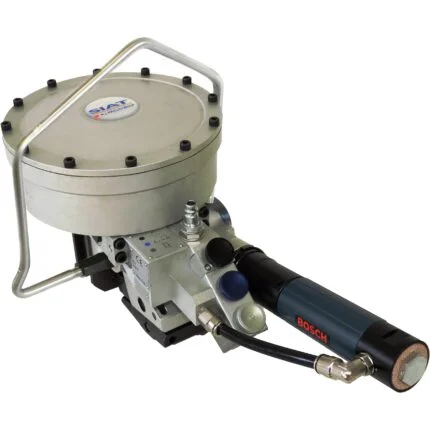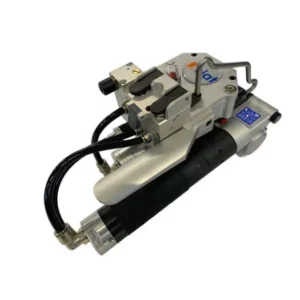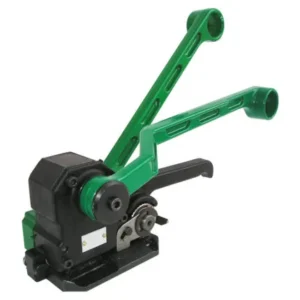the steel strapping tools get it from hadanco now

the steel strapping tools are required in industries where big or bulky products must be securely fastened, such as shipping, construction, and manufacturing. The usage of these instruments guarantees that the products are kept intact during transport and storage, lowering the chance of damage. And through the following lines we are going to provide you with some more important details about steel strapping tools.
what is the steel strapping tools ? 👈get it now
Steel strapping tools are devices that use steel strapping to secure, bundle, or reinforce goods, especially in industrial and transportation applications.
Steel strapping, often known as steel banding, is a high-tensile material that offers powerful and long-lasting security solutions.
what are the uses of steel strapping tools?

Steel strapping tools are used in a variety of applications to provide safe packing, reinforcing, and transportation of large or bulky products. Here are some common applications:
Shipping and Transport:
Steel strapping is used to secure things on pallets and prevent them from moving during transit.
Container loading involves strapping goods to prevent them from shifting inside shipping containers.
Construction:
Steel strapping is used to bundle rebar and other building supplies so that they may be easily handled and transported.
Securing Scaffolding: It aids in the securement of scaffolding components and other building materials.
Rail Transportation:
Securing Cargo on Rail Cars: Steel strapping holds cargo in place during rail transit, lowering the danger of movement and damage.
Automotive:
Bundling Parts: Automotive parts and components are packaged and secured for safe delivery to assembly plants or distributors.
Agriculture:
Steel strapping is used to bundle hay and other agricultural products for storage and transportation.
Heavy machinery:
Securing Heavy Equipment: Large, heavy machinery is strapped to avoid movement and potential damage during transportation.
Manufacturing:
Steel strapping secures metal coils and sheets during manufacturing and shipping.
Equipment and Machinery: Large machinery and equipment parts are secured to prevent damage during transportation.
Timber:
Logs and timber lashed together to keep the bundle intact during transportation.
Sheets of plywood and boards tied together for ease handling and shipment.
Choosing the Right Steel Strapping Tools for Your Packaging Needs
Choosing the ideal steel strapping equipment for your packaging needs entails taking into account a number of aspects to ensure that you get the best products for your unique needs. Here’s a guide we prepared it at Hadanco to help you make an informed decision:
Understand Your Strapping Requirements.
Load Weight and Size: Heavy and bulky loads may necessitate stronger equipment and strapping materials.
Load Stability: Consider if the load may vibrate or move during transit.
Package Type: Different packages (such as pallets, cartons, and bundles) may necessitate different strapping techniques.
Evaluate tool features.
Ease of Use: Ergonomic designs lessen operator fatigue.
Durability: Look for tools built of high-quality materials that can sustain heavy-duty use.
Tensioning Capacity: Make sure the tool can apply enough tension for your load requirements.
Seal Type: Determine whether you require equipment for crimping seals, buckles, or friction-weld seals (common in battery-powered instruments).
Budget
Initial Investment vs. Long-term Costs. Compare the initial cost of the tools to their durability and the cost of maintenance and repairs.
Quality vs. Cost: Investing in higher-quality tools can result in reduced long-term expenditures due to fewer replacements and repairs.
Provider Assistance
Customer service: Choose providers like Hadanco, which could provide excellent post-purchase and customer service.
Warranty and Repairs: To guarantee long-term tool support, take into account the availability of warranties and repair services.
Top Must-Have Steel Strapping Tools for Efficient Packaging
The correct steel strapping equipment is essential for ensuring efficient and secure packaging. Here are the best steel strapping tools for efficient packaging:
Manual Steel Strapping Tools 👈choose yours now

steel strapping tools
Tensioners:
Function: Apply tension to the steel strapping.
Usage: Suitable for modest to moderate volume applications.
Examples include feedwheel and windlass tensioners.
Sealers:
Function: Crimp a metal seal or buckle to tighten strapping.
Usage: Requires manual force and is appropriate for a variety of strapping widths.
Combination tools:
Function: This tool combines tensioning and sealing capabilities.
Usage: Simplifies the strapping process, which is beneficial for smaller enterprises.
Pneumatic steel strapping tools.👈 see more tools

Pneumatic tensioners:
Function: Tightens the strapping with compressed air.
Usage: Ideal for high-volume activities; decreases operator fatigue.
Example: a pneumatic feed wheel tensioner.
Pneumatic sealers:
Uses air pressure to crimp seals or buckles.
Use: Provides consistent sealing pressure, making it perfect for heavy-duty applications.
Examples include pneumatic single-notch sealers.
Pneumatic Combination Tools:
Function: Combines tensioning and sealing, powered by compressed air.
Usage: Improves efficiency and uniformity in high-volume environments.
battery steel strapping machines👈 buy now

steel strapping tools
Fully automatic strapping machines:
Function: Automatically tensions, seals, and cuts.
Application: High-speed, high-volume processes incorporated into production lines.
Tips for Using Steel Strapping Tools Safely and Effectively
Using steel strapping tools properly and effectively is critical to ensuring not just package security but also operator safety. Here are some suggestions to help you accomplish both:
Safety Tips:
Wear protective gear.
Gloves protect hands from cuts and abrasions.
Eye Protection:
Use safety glasses to protect your eyes from flying debris and strapping recoil.
Steel-Toed Boots: Protect your feet from heavy things or tools that may fall.
Proper Training:
Ensure that all personnel trained in the proper use of strapping tools.
Regularly update training to reflect new safety measures and tool features.
Useful Tips
- Select the Right Tools:
Choose tools that are appropriate for the strapping width and thickness you’re employing.
Use combination tools to streamline procedures when suitable.
- Apply the correct tension:
Ensure that the strapping correctly tensioned – neither too loose nor too tight.
Use tensioners with flexible tension settings to meet varying load needs.
Finally, through the previous lines you could find all details you may need to know about steel strapping tools types and usage, and for more details, contact our team at Hadanco now.
